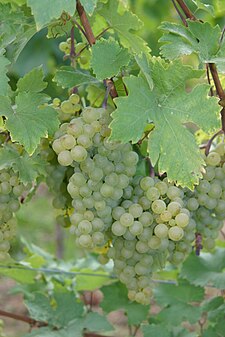Ehrenbreitsteiner
Ehrenbreitsteiner is a white grape variety that was bred by Helmut Becker in 1964 at the Geisenheim Research Station in Geisenheim . It is a cross between the Ehrenfelser x Reichensteiner grape varieties . Becker's basic idea was to develop new grape varieties that would prove to be more resistant to phylloxera and fungi than the traditional grapes. In addition to the Ehrenbreitsteiner, the new varieties named Dakapo , Prinzipal , Rondo and Saphira also belong in this context . The variety received plant variety protection in 1994 and was added to the variety list in the same year. The wine by no means grows at the Ehrenbreitstein Fortress . Becker also had no substantial connection with Koblenz . Rather, the name is explained by a blending of the parent grape varieties with a free association of the middle morpheme in an homage to the well-known defense system over the Rhine.
There are small wooded areas in Germany , Canada , Austria , Hungary and Italy . The variety only plays a subordinate role on the wine market.
The wine type is reminiscent of a Riesling in terms of taste , but looks different with its greenish-yellow color. It grows more undemanding in Müller-Thurgau locations. The variety ripens around two weeks earlier than Riesling and produces fragrant, acidic wines (→ acidity (wine) ).
Synonyms: Breeding number Geisenheim 6414-36 (Gm 6414-36)
Parentage: Ehrenfelser x Reichensteiner
Distribution in Germany
In 2007, 10 hectares of planted vineyards were surveyed in Germany , which are distributed among the individual wine-growing areas as follows:
| Wine region | Vineyards (hectares) |
| Ahr | - |
| to bathe | - |
| Francs | - |
| Hessian mountain road | - |
| Middle Rhine | below 0.5 |
| Moselle | 1 |
| Near | - |
| Palatinate | below 0.5 |
| Rheingau | 1 |
| Rheinhessen | 8th |
| Saale-Unstrut | - |
| Saxony | - |
| Stargarder Land | - |
| Württemberg | - |
| TOTAL Germany 2007 | 10 |
Source: Vineyard statistics from March 13, 2008, Federal Statistical Office , Wiesbaden 2008 in Descriptive Variety List of the Federal Variety Office 2008, page 198ff.
Ampelographic varietal characteristics
In ampelography , the habitus is described as follows:
- The shoot tip is open. It is lightly to moderately hairy white wool. The young leaves are light green and slightly bronze colored (anthocyanin spots).
- The medium-sized leaves are five-lobed. The stem bay is closed in a V-shape. The blade is bluntly serrated. The teeth are coarse compared to the grape varieties. The leaf surface (also called blade) is moderately blistered and coarse.
- The cylindrical to cone-shaped grape is rarely shouldered, small to medium-sized and moderately dense. The round berries are small to medium-sized and yellow-green in color.
The Ehrenbreitsteiner sprouts medium late and is therefore not very sensitive to possible late spring frosts. With good wood ripeness, it is characterized by good winter frost hardiness. The variety is less susceptible to powdery mildew and moderately susceptible to downy mildew and gray mold rot .
Individual evidence
literature
- Walter Hillebrand, Heinz Lott, Franz Pfaff: Paperback of the grape varieties. 13th, revised edition. Fachverlag Fraund, Mainz 2003, ISBN 3-921156-53-X .
